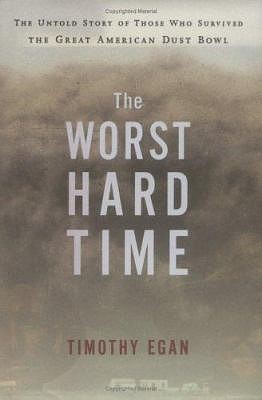On Sept. 14, 1930, an enormous black dust cloud billowed up out of southwest Kansas, hit Oklahoma, and rolled on with ominous intent through the Texas Panhandle. No one had seen the like of it before and did not know what to make of it. This dust storm was the first to appear on the High Plains, but it would not be the last nor would it be the worst that the people of No Man's Land would face or come to fear within the next 10 years.
It happened during a decade already devastated and impoverished by the Great Depression. Once the domain of Native American Indian tribes and the great buffalo herds, America's ancient grasses of the plain had held the ground in place for twenty thousand years. It was gone in the time it took for the hand-held plow followed by the motorized tractor to plow it up. The top soil of earth blew away only to come raging back on the "sodbusters," who watched from their dugouts in awe and trepidation as the earth turned on them with a vengeance.
Pulitzer Prize winning author Timothy Egan follows the saga of this terrible time in American history, focusing on the stories of the people who lived through it. Published in 2006, "The Worst Hard Time: The Untold Story of Those Who Survived the Great American Dust Bowl" examines this environmental tragedy, rated as the leading weather event of the 20th century by American meteorologists.
During the agricultural boom of the late 1800s into the 1920s, it was believed that the soil was immutable, that it could not be exhausted or used up. This line of thought was encouraged by the United States government to populate the barren High Plains. More importantly, the land was going to make everyone rich and the desire to possess their own little piece of earth was a driving force behind the immigration west. Egan fills his narrative with such diverse characters as the cowboy, the homesteader, the wealthy businessman, the con artist and the simple farmer, all of whom embraced those heady days of the boom years only to turn around and watch it blow away in a cloud of dust.
Black blizzards of dust boiled up on the plains giving a new moniker to the era, the "Dirty Thirties." Dust piled up like snow on the ground, dust dunes covered cars and houses completely, dust tainted everyday life. It got into the hair, the eyes, the nose, the throat. It got into the food and filled up wells. Horses went mad and dust got into the digestive tracts of the cattle. Farm animals could not feed out in the pasture because the pasture was buried in the dust. Both animals and people began to starve. Worst of all, lungs filled with the fine particles of dust so that people became ill and died of what was called "dust pneumonia." Egan writes, "It was a time when taking a simple breath was a threat."
"The Worst Hard Time" is a book that forces us to take a look at the damage humans can do to their own environment and the steps we can take it to ensure it does not happen again. Timothy Egan writes that "the great grasslands of the Native American and the bison came through the dirty decade deeply scarred and forever changed."
The Dust Bowl was a hard and bitter lesson of how man disturbed the balance of nature and how nature retaliated. It is still considered to be the nation's worst prolonged environmental disaster today.
Kimberly Bolton is a circulation clerk with Missouri River Regional Library.

